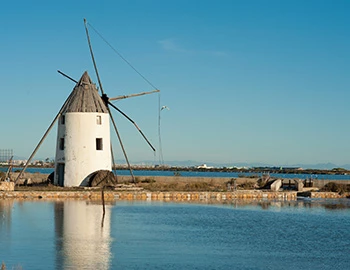Rioja
Rioja: A legend in upheaval
It is the flagship of the Spanish wine industry: the Rioja region, with its elegant, yet storable wines, most of which are dominated by the Tempranillo, has decisively influenced the image of Spanish wine. Above all, the Reservas and Gran Reservas, aged for years in barrels, enjoy a magical reputation. For about 20 years, the Rioja houses have created a sensation with modern-designed, fruity wines, which are marked more by their terroir than their aging processes.
White wines from Rioja
Red wines from Rioja
The international success of Rioja began after 1840. At the time, phylloxera was destroying the vineyards of Bordeaux. The French wine merchants searched for replacements and found them in Rioja. The formidable cellars in the neighbourhood around Haro’s main train station, from which wines were once transported to Bordeaux, still bear witness to the boom of those years. When phylloxera reached Rioja after 1900, this boom turned to bust.
Aged wines
The area only began to experience a renaissance after 1970, thanks to the introduction of a rating system with the designations: Gran Reserva (aged at least five years before sale), Reserva (aged at least three years) and Crianza (aged at least two years). Traditional houses often put their Gran Reservas on sale only after seven or ten years. In recent years, however, Riojas are also increasingly coming onto the market that are referred to as "designer wines" (created by wineries) or crus (selections from individual vine plots). These often have greater concentration and fruitiness than the classical Riojas.
Three subregions
The Rioja region is a 100-kilometre-long and 40-kilometre-wide strip along the Ebro. Alluvial soils with high gravel content dominate near the river; otherwise, the vines are rooted in clay with varying proportions of lime and iron. The valley is bounded to the north by the Sierra de Cantabria and lies at the junction of cooler Atlantic air and a moderate Mediterranean climate. The total vineyard area of 62,000 hectares is divided into three subregions. From the Rioja Alta and the adjacent Rioja Alavesa, elegant and storable wines emerge in relatively high positions with the influence of the cool Atlantic, while fuller wines are produced in the warmer Rioja Baja.
The Tempranillo dominates
The classic Rioja is a blend of Tempranillo (for strength and support), Garnacha and Mazuelo (to provide fruit and melodiousness) and the acidic Graciano. Over the past 30 years, however, the Tempranillo has steadily gained in importance. Elegant white wines are also produced.










